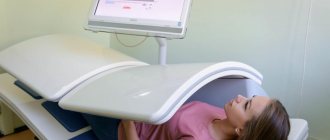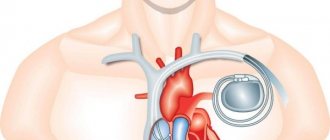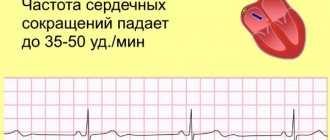If you train remotely or attend in-person classes, you've probably noticed that your instructor repeatedly asks you to take your heart rate during training. Let's figure out how to do it correctly and why it's done.
| Pulse (pulse wave) is a heartbeat that spreads along the walls of blood vessels. Normally, heart rate (heart rate) is equal to the pulse and at rest is 60-90 beats per minute. |
It is more convenient to measure the pulse in places where the walls of the arteries are located close to the skin:
- carotid artery (during training we count the pulse using it);
- radial artery (the doctor usually measures the pulse there);
- temporal artery;
- inguinal artery.
Rules for measuring pulse
Measuring the pulse on the carotid artery: place your fingertips perpendicularly to the line connecting the head and neck (approximately halfway between the ear and chin). You should feel the rhythmic beating of the artery under your fingers.
Now, looking at the second hand of a watch or a stopwatch, we count the number of beats in 10 seconds and multiply by 6. We get the pulse rate in 1 minute. For example, in 10 seconds there are 13 beats, which means that the pulse in 1 minute is 78 beats.
We recommend taking your pulse in the morning while lying down (without getting out of bed). After moving to a sitting position, immediately repeat the measurement (in a sitting position, the pulse will increase).
| If the readings differ by more than 10 beats per minute, this may mean overwork during the previous training session or insufficient sleep. |
It is necessary to analyze the daily routine and the correspondence of the volume of training to your level of training and condition. It is possible to reduce the load (by reducing the intensity or number of workouts).
Heart rate
If you record your heart rate every morning, then over time (against the background of regular training for 4-6 or more weeks) you will notice that this value decreases slightly, that is, the heart beats fewer times per minute than before the start of training.
This is due to the fact that with regular physical activity you train the heart muscle, and the heart adjusts to a more economical mode of operation. This is a normal physiological phenomenon. For people who train for a long time (professional athletes), the heart rate per minute is 48-58 beats.
| The most effective activities for training the cardiorespiratory system are aerobics, interval training, running, and cycling. |
If you have not trained before, and the initial pulse during repeated self-monitoring is less than 55-60 beats per minute, even if you feel well (no complaints), we recommend consulting a doctor, as this may be a sign of a heart disorder (weakness of the sinus node , blockades of varying degrees and other conditions).
If a rapid pulse is constantly detected - more than 90 beats per minute - this may be a consequence of your uncomfortable emotional state (excitement, anxiety, etc.), and may also be a sign of various pathological conditions (a cold or the recovery period after it, anemia , diseases of the thyroid gland, etc.), requiring examination by a doctor, after which a decision will be made on the possibility and volume of the load.
Pulse rhythm
Normally, the pulse wave propagates at regular intervals. There is a minimal error - during self-control it is invisible.
If, when counting the pulse, there is a feeling that it is slowing down, or the beat “falls out” (often this is accompanied by a subjective feeling of “interruptions” in the heart’s work, “fading”, “reversal” of the heart), we recommend that you consult a therapist or cardiologist. Based on the results of the examination, a decision will be made on the need for additional examination, the possibility and volume of training load.
How the heart works while running
The heart is a muscle, which means, like any other muscle, it can be trained.
When we run, the body's (and muscles') need for oxygen increases significantly, which means the heart must deliver a larger volume of blood to them than at rest. The unit of measurement here is usually taken as the minute volume (MV), that is, the volume of blood that the heart can “distill” in one minute. It is calculated using a simple formula:
MO = SV x HR
What are these scary abbreviations? Let's explain.
Stroke volume (SV) is the amount of blood that the heart pumps out in one beat.
Heart rate is the number of heart beats per minute (almost the same as pulse). You can learn more about heart rate here.
As these indicators increase, the minute volume of blood also increases. It would seem that this is what we are trying to achieve? If heart rate increases, will minute volume also increase? Will the muscles receive more blood, will the body be able to cope with the load better? Not certainly in that way. When we run for a long time at a high heart rate, we simply do not allow the heart to rest between beats; it does not have time to pump enough oxygen, and we rather harm it than help it develop.
Heart rate during exercise
| Maximum heart rate is the maximum number of heartbeats per minute. This value depends on age and concomitant diseases. |
Measuring your heart rate before training should be done in a calm environment (without previous load). Excitement, laughter, other emotions, physical activity (running, jumping, fast walking), and a short period of rest after a previous workout can change normal readings. If possible, take the measurement again.
| If the pulse rate before the start of training is 10-15 beats per 10 seconds (60-90 beats/min), you can begin the volume of load that is determined for you. |
Most often, the maximum frequency (FR (max)) is calculated using the Haskell-Fox formula: FR (max) = 220 – age.
| Karvonen's formula is more accurate: HR during training = (maximum heart rate - resting heart rate) * intensity (in percent) + resting heart rate. |
None of the formulas have scientific accuracy ; however, focusing on their indicators, you can control the level of load during training.
You can use a less labor-intensive calculation: taking into account the fact that maximum performance develops when the pulse reaches 170-180 beats per minute, we will take this value as 80-90% of the emergency rate (max.) and will carry out all calculations based on it. This way we will get optimal heart rate readings during training.
During training, the heart rate increases - this is natural and absolutely normal. By monitoring our pulse and entering it into different pulse zones, we can set and control the intensity of the workout, receive important information about our condition and the ability to prevent undesirable consequences.
What is MCHSS
Pulse is an individual thing, depending on:
- age,
- physical fitness,
- body weight,
- presence of bad habits,
- simply on the level of stress.
Therefore, it is better to treat categorical recommendations to “train at a heart rate of 120” addressed to a wide audience with a healthy dose of skepticism.
How to calculate your personal norm?
Knowing your personal maximum heart rate (MHR), you can determine your pulse zones, and build your training plan in accordance with them.
MHR is the maximum number of heart contractions per minute that is achieved at the limit of the body's capabilities. It can be determined either in laboratory conditions, for example, in a sports clinic (the most accurate and accurate way), or using one of the formulas:
- Standard: MHR = 220 – (minus) your age
- More modern: MHR for men = 214-(0.8 x age), MHR for women = 209-(0.9 x age).
Pulse zones
There are 5 pulse zones, and each subsequent one will differ in that the pulse in it is higher, respectively, in the first pulse zone the load will be minimal, and in the fifth – maximum.
Zone 1. Recovery or “therapeutic” zone.
The pulse value in this zone is 50-60% of the maximum heart rate (HR), which you can calculate using the formulas given above . The pulse value in the first zone will be approximately half of the resulting number.
Training in this range will be useful for those who have just embarked on the path to healing the body and have poor physical fitness. Loads of this intensity train the heart without unnecessary risk. Any person can carry out loads in this zone without fear for their health. It is recommended to warm up and cool down in this heart rate zone.
Zone 2. Fat burning zone.
The heart rate in this zone is 60-70% of the maximum heart rate . Suitable for anyone with frequent, low-intensity workouts. When training in this range, the fat burning mechanism is activated, and body weight loss occurs due to subcutaneous fat tissue.
In this pulse zone, overall endurance is strengthened and fat burning processes are stimulated.
There is one BUT: we remember that fat burning begins 30-40 minutes after the start of the load, so working at such a pulse should be at least 30-40 minutes. Target sensations: easy breathing, low muscle load, light sweating.
Zone 3. Strength endurance zone.
The heart rate is 70-80% of the maximum heart rate. If you fall into this zone, then the training is effective and you are improving your performance. However, staying in this zone should be short-term, because only trained people, athletes, can work for a long time at such a pulse.
This zone is best suited for increasing the body's endurance. Load duration: 10 minutes or more (depending on fitness; the more trained the body, the longer the interval of stay in this zone). It is this zone that we try to catch during maximum load in the middle of a workout, when we count the pulse.
Zone 4. Improvement zone.
The heart rate is 80-90% of the maximum heart rate. When training at this pulse, anaerobic endurance increases and the ability to achieve maximum results increases.
Load duration: 2-10 minutes. Most often, this zone is used during training by athletes or people who train for a long time.
Zone 5. Maximum heart rate zone.
Heart rate: 90-100% of maximum. This zone is rarely used, in preparation for competitions exclusively by professional athletes.
We have created a convenient tool for you to calculate your individual heart rate zones. You can print it out, enter your calculated values and use this data when planning your training process.
Optimal heart rate indicators:
- During warm-up, the heart rate should not exceed 20 beats. in 10 sec. (120 beats/min). The measurement should be taken immediately after completing a dynamic warm-up (before the inhalation-exhalation cycles). If after the warm-up your heart rate is more than 15 beats per 10 seconds (90 beats/min), then most likely the warm-up was too intense for you.
- During the main part of the workout, the heart rate should be within 27-30 beats per 10 seconds (162-180 beats/min) and not exceed this value (take measurements at the peak of the load in order to be able to adjust the load level). If you find a lower heart rate, try doing the exercise at a faster speed. If, when monitoring your heart rate during the main part of the workout, you received a value exceeding 27-30 beats per 10 seconds (170-180 beats/min), we recommend reducing the load by switching to a lighter option (if you initially performed it, reduce the pace of the exercises or increase rest intervals).
- For people who have not previously exercised, we recommend that the first 2 weeks exercise less intensely, so that the heart rate at the peak of the load does not exceed 25 beats in 10 seconds (150 beats/min). In subsequent weeks, with good load tolerance, it is possible to increase the intensity to a heart rate of 27-30 beats. in 10 sec.
- Upon completion of the cool-down and stretching (15 minutes after training), the heart rate should return to its original value - the one you measured before training. This indicates good recovery of the body and indicates a correctly selected load. At first, a rapid pulse may persist after training, which indicates that the body is poorly trained, or that the load is too high. If you train for a long time, such repeated incomplete recovery may indicate overwork. Then analyze your regime, diet, training cycle and make adjustments so that the exercises are beneficial.
In order not to harm yourself and to properly train your cardio-respiratory system, it is important to train according to pulse zones.
| Start and end the workout in the first heart rate zone (50-60% of the maximum), gradually move through the second zone to the third, bringing the heart rate to 80% of the maximum, and end the workout with a decrease in heart rate. |
Thus, the body will receive a harmonious load, and fitness will increase.
Author: Irina Yakimova, sports doctor #SEKTA, candidate of medical sciences, general practitioner
What do the experts say?
“Running by pulse helps me more accurately understand my condition before, during and after exercise, and always correctly determine my body’s response to the load. In addition, this is an indicator by which it is convenient to compare training results and track progress,” says MySportExpert manager Nina Sukhareva.
“It seems right to me to build my training schedule based on heart rate readings. I myself have some heart problems, so I make sure to do a control test twice a year - I update the readings of the pulse zones,” says Denis Titov, running expert.
Runners who took part in a poll on MySportExpert social networks also voted “for” heart rate training. To the question “Do you take heart rate data into account when planning your running training schedule?” 90% of participants responded positively.
Briefly
- Heart rate training is an effective and safe way to increase your endurance and improve your running performance.
- The heart is a muscle, and it can be trained. Running develops the heart if in our training plan we competently combine activities in different heart rate zones.
- It is recommended to carry out the main volume of training in the aerobic heart rate zone (alarm bell: if you cannot calmly carry on conversations while running, you have already left the aerobic zone).
- By running slowly, we develop our heart muscle, which in the future will give us a reserve for improving results, including speed.
- Recovery is the key to successful training. Don't push your body.
— Understanding heart rate zones and creating a training schedule, especially in the early stages, can seem like a daunting task. It is important to know that there is someone more experienced nearby who can help, guide and monitor. For example, during group classes under the guidance of an experienced trainer, you can completely devote yourself to training and trust a professional who will pay attention to each athlete and help make the training effective specifically for him. You can sign up for training on our website or by phone.











